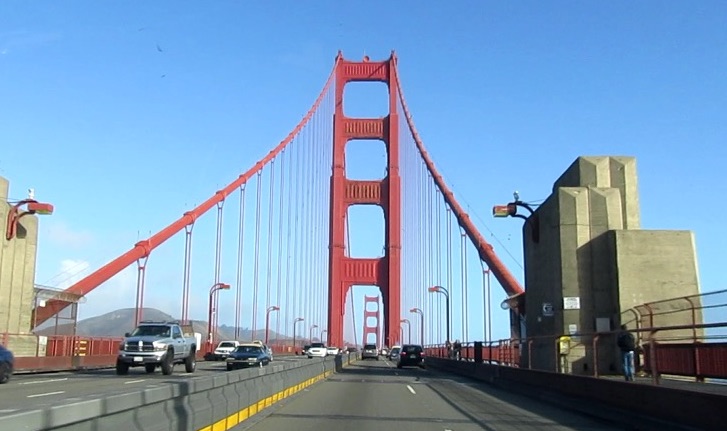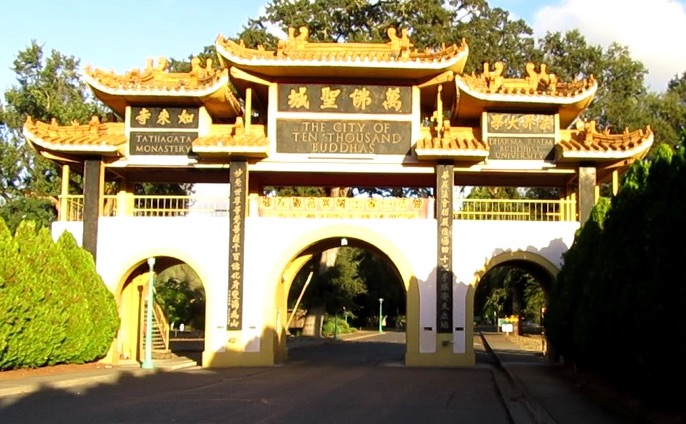SACRAMENTO, CLEAR LAKE AND TEN THOUSAND BUDDHAS

The iconic Golden Gate Bridge of San Francisco
After the chi kung courses in San Francisco, Andrew and I drove north from San Francisco on 17th October 2016. We passed the iconic Golden Gate Bridge and headed north on an expressway. There were numerous towns on the way.
At the junction to Mapa we left the expressway to go on country roads. “Mapa”, Andrew told me, “is an important area for winery. There are a lot of vineyards here.” We passed many short grape trees on both sides of the road.
We reached a large wine factory and Andrew drove in. It was beautiful with rows of grape trees everywhere. We reached some impressive buildings.
"Is this impressive building the factory producing wine?" I asked.
"No, it’s a restaurant."
We passed another smaller but still impressive building not far away. "Sigung, this building is for people to taste a great variety of wine. Would you like to taste some?"
"No," I replied. "Wine is not my fancy. But if you like to taste some wine, I can join you."
"Wine is not my fancy too," Andrew replied. "I prefer to keep my head clear. I think wine is over-rated as a beverage."
"A lot of people drink wine," I said. "If you dine in a restaurant in Spain, you are always given red wine, even though you may not drink it."
Instead of tasting wine, we tasted ice-cream. Ice-cream, to me, was more tasty. I believe Andrew agreed too, based on the delightful expression on his face. The ice-cream palour situated inside a long building was in a little, delightful town called Williams, some distance from Mapa.
Soon we reached Sacramento, the capital of California. Sacramento is a charming little city with tree-lined streets but not heavy traffic. We passed the State Museum with its splendid dome. The State Museum was formerly used as the State Administrative Building.
But I was more attracted by some pretty women in front of the building instead of its splendid dome. The women looked Chinese, and were wearing blue cheongsams with matching blue umbrellas. They were performing some elegant dance in front of some spectators.
"Let’s stop and look at the dance," I said, and of course the dance included the lovely women. I am not sure whether Andrew understood the subtle interpretation, but he promptly parked his car at the roadside.
The lovely women were indeed Chinese. Not only they looked Chinese and wore cheongsams, they spoke Chinese Mandarin too. The women had finished their dance, and were posing for some photographs, keenly taken by a few spectators.
"The women did not publicize their dance well," I commented. "The crowd enjoying their dance is small." But I managed to ask one of the women what the dance was about. “It’s a pipa festival,” she said. Pipa is a kind of Chinese lute.
We then drove around town and nearby streets, which were quite quiet. We adjourned to a Chinese restaurant for lunch. The food was delicious, but the price very low.
"Sometimes I wonder how these restaurants can survive," I said
"Sacramento is cheaper than San Francisco," Andrew replied.
"Even in New York, which is expensive, Chinese food is cheap, but delicious. I once asked Eugene how the Chinese could survive with the low prices they charged. And Eugene said that they never got out of China town."
As we left Sacramento, we went along long stretches of arid land, reminding me that California is quite dry. It also reminded me of the interesting journey through American deserts from Los Angeles to Las Vegas many years ago.
After some time we drove alongside a beautiful lake, called Clear Lake, though the water was not actually clear. But the scene was lovely. There were a few private piers jutting out into the lakes.
"The lake is not wide," I told Andrew. "One could swim across it."
But soon the narrow lake opened to a large expanse of water. With the sun shinning on the water, it made a magnificent scene. Further up the road, there was even a harbor with a large area but no ships or even small boats around, but with two separate piers running into the lake and enclosing a part of it with an opening. It was fun walking along the piers and admiring the open expanse of water.
After Clear Lake, we drove a long way through the redwood forest amidst winding roads on rolling hills to the City of Ten Thousand Buddhas in Ukiah. I had a nap in the car while Andrew did the tedious driving. Suddenly I found the car stopped.
As I opened my eyes I found we were in the middle of a quiet road, but right in front was a majestic gate announcing the entrance to the City of Ten Thousand Buddhas. It was kind of Andrew to stop the car so that we could take some memorable photos.
The City of Ten Thousand Buddhas was a large area with a main Buddha Hall, a university, a middle school, an elementary school, and separate quarters for monks, nuns and lay people. There were a few exquisite peacocks on the quiet roads inside the city.
We visited the main Buddha Hall. There was a gigantic statue of Avalokitesvara Bodhisattva, or Guan Yin Budh Satt in Chinese, with a thousand hands. There were also large statues of other Buddhist deities and 10,000 smaller statues of Buddha.
We saw some smartly dressed monks and nuns in their kasaya, or Buddhist robes, walking briskly to the Buddha Hall, probably for their evening sutra recitation. The place was quite, probably observing the practice of “no talking”.
We drove around the quiet city. We saw some volunteers sweeping the spotlessly clean roads. We even saw an art studio, entered it but found no one insdie. But the material and apparatus for art were well arranged in proper order.
We went to the vegetarian restaurant in the city but it was close. So, as we were not monks, we went to a steak house in Ukiah town to have dinner. Andrew, however, had spaghetti instead. After dinner we adjourned to a comfortable motel for the night.
Grandmaster Wong Kiew Kit,
18th October 2016.

City of Ten Thousand Buddhas in California
LINKS
Courses and Classes
